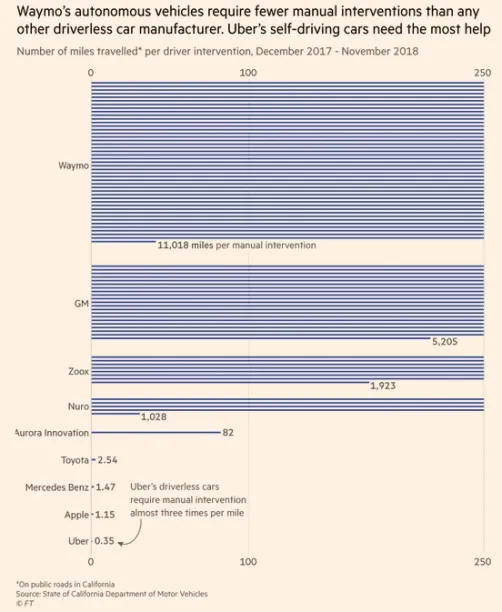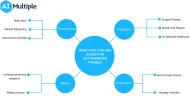We compiled 40 up-to-date autonomous vehicle statistics from the surveys and research of reputable sources. In this list, you will find self-driving stats that will help you understand the present and future of self-driving market.
Market forecasts
- 55% of small businesses believe fleets are expected to be fully autonomous within 20 years. (Nissan News)
- The global autonomous car market is expected to grow from $5.6 billion in 2018 to $60 billion in 2030. The market definition includes component production and investments. (Businesswire)
- Annual production levels of robo-cars are expected to reach 800,000 units worldwide by 2030. (Statista*)
Read more: Autonomous things.
Adoption
- In 2018, more than 1,400 self-driving cars, trucks, and other vehicles were in testing by more than 80 companies across 36 U.S. states and Washington DC. (TedCrunch)
- In 2019, 48 automobile and technology companies gave their testing reports to California’s DMV, including Apple, Samsung, BMW, and Mercedes-Benz. (FT)
- In 2018, more than 1.59 million registered drones were in the U.S., of which more than 372,000 were classified as commercial, with more than 136,000 registered as commercial data. (TechCrunch)
- China has the potential to become the world’s largest market for autonomous vehicles. According to McKinsey’s forecast, such vehicles could account for as much as 66% of the passenger kilometers traveled in 2040. (Mckinsey)
How do people feel about self-driving vehicles?
- Only 16% of respondents are “very likely” to ride as a passenger in an autonomous vehicle, while 28% of respondents state that they “not likely at all”. (Morning Consult)
- 22% of respondents believe self-driving cars are safer than the average human driver, while 35% of them believe self-driving cars are less safe than the average human driver. (Morning Consult)
- 57% of Americans familiar with self-driving cars are willing to ride in them. (US News)
- 51% of US citizens are interested in laws to make sure self-driving cars are safe.(American Automobile Association)
- 49% of US citizens want to know how vulnerable they will be to hackers. (American Automobile Association)
- 72% of U.S. adults would feel safer riding in a self-driving car if they could take over control if something goes wrong. (American Automobile Association)
- 57% of US citizens say they would like to have a clear understanding of who will be legally responsible in the event of a crash with a self-driving vehicle. (American Automobile Association)
- According to consumers, the main barriers preventing consumers worldwide from adopting self-driving vehicles are
- Vehicle security against hackers (73%)
- System security against hackers (72%)
- Self-driving vehicles getting confused by unexpected situations (71%) (Statista**)
How COVID-19 changed public opinion on self driving cars
- 26% of consumers now view autonomous delivery technologies more favorably than before the coronavirus health crisis. (Consumer Technology Association)
- 49% of US consumers rate autonomous delivery technologies as somewhat or very favorable. (Consumer Technology Association)
- Lyft and Aptiv have successfully provided 100,000 commercial robotaxi rides in Las Vegas. 98% of these paying passengers have given 5 stars to their self-driving ride experience, with most stating this first-of-a-kind experience is something they are eager to try again. (Aptiv)
Facts & stats on self-driving vehicle accidents
- On November 20, 2018, the Uber crash in Tempe was the first recorded case of a pedestrian fatality involving a self-driving (autonomous) car. Uber self-driving cars were involved in 37 minor crashes before the crash that led to the death of Elaine Hezerberg. (Wikipedia)
- Uber determined that the crash in Arizona was caused by the car’s sensors identifying the pedestrian, but considering the victim as a false-positive, raising concerns of similar accidents in the future. (The Information)
- Google’s autonomous car, Lexus SUV, crashed with a bus in February 2016. (The Verge)
- Google’s Waymo had 18 minor accidents from 2019 through the first nine months of 2020. (Venture Beat)
- Tesla Model S and Tesla Model 3 caused fatal accidents in June 2016 and March 2019 while in autopilot mode. In both scenarios, the driver died. (Wired*)
- On average, a fatality occurs every 94 million miles in the US and every 60 million miles worldwide. According to Tesla, its Autopilot had been used for more than 130 million miles until its first fatal accident. However, this is not an apples-to-apples comparison as autopilot is used more often on highways and we couldn’t find more detailed data on crashes due to human error to do a better comparison. (The Verge*)
- Autonomous Vehicles (AVs) got into more crashes overall: 9.1 crashes per million miles driven, compared with 4.1 crashes per million miles for conventional vehicles. However, the ones involving injury were minor compared with the injuries sustained during conventional vehicle crashes. (GovTech)
Interesting self-driving statistics
- Waymo cars hold the most autonomous miles. In 2020, Waymo has driven 20 million miles on public roads in 25 US cities. (VentureBeat)
- Waymo has conducted over 20 billion miles of simulation testing using synthetically generated data. (Waymo)
- Japan-based Tsukuba Mechanical produced the first autonomous passenger vehicle in 1977 that could recognize street markings while traveling at nearly 20 miles per hour, thanks to two vehicle-mounted cameras. (Wired)
- Self-driving cars, circling an area repeatedly (i.e. the passenger dropping off near a bank instead of parking the car, and the car circling a specified route until the passenger comes back and the car picks them up) leads to higher traffic congestion and lower traffic speed. (New Atlas)
- With pedestrians being more unpredictable in their movements than cars, the former poses a bigger challenge to self-driving cars’ software applications than the latter (Ars Technica).
- Research has shown that Waymo’s self-driving cars require the least number of manual interventions, and Uber’s needs the most. (FT)

Investments in Self Driving Vehicles
Tech giants
- Waymo has raised a total of $3B in funding over 2 rounds. (Crunchbase)
- Tesla has raised a total of $20.2B in funding over 35 rounds. (Crunchbase)
- Audi plans to spend close to $16B on self-driving and sustainable tech by 2023. (CBInsights)
- Uber Advanced Technologies Group has raised a total of $1B in funding to further their research and make self-driving technology safer. (Crunchbase)
Key startups
- Rivian has raised a total of $8.2B in funding over 9 rounds. (Crunchbase)
- Cruise has raised a total of $7.3B in funding over 8 rounds. (Crunchbase)
- Nuro has raised a total of $1.5B in funding over 4 rounds. (Crunchbase)
- Aurora has raised a total of $1.1B in funding over 3 rounds. (Crunchbase)
- Zoox has raised a total of $1B in funding over 6 rounds (Crunchbase)
- AIWAYS has raised a total of CN¥5.2B in funding over 4 rounds (Crunchbase)
For more on autonomous technology
If you want to learn more about autonomous technology, read:
- Autonomous Things (Aut): Why it matters, Examples & Pitfalls
And if you still have questions on self driving cars and/or autonomous technology, don’t hesitate to contact us:


Comments
Your email address will not be published. All fields are required.